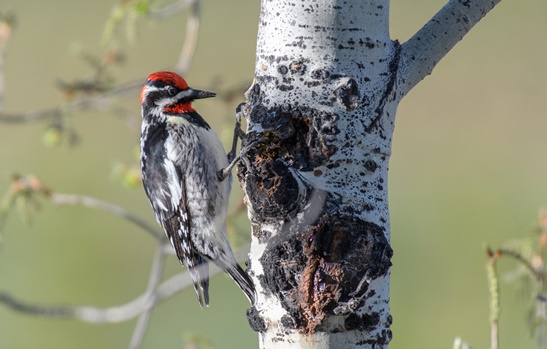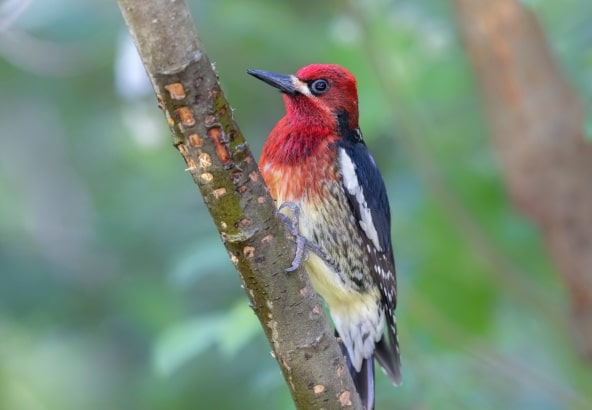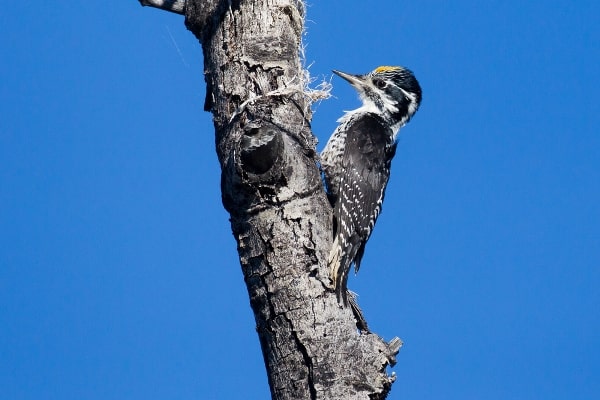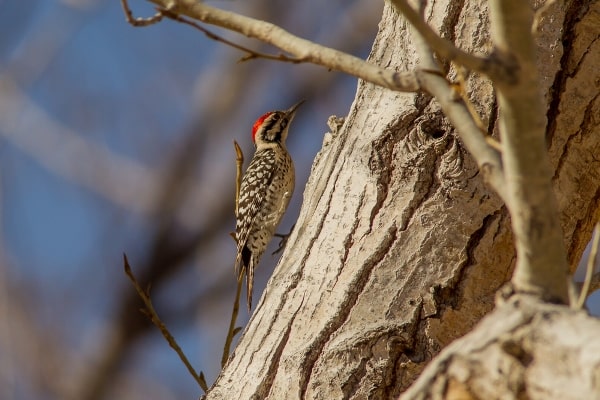Colorado is a beautiful state, with the majestic Rocky Mountains dominating the western part. On the eastern half, you can find arid deserts and flat, open landscapes.
The delightful mix of these two landscapes in Colorado appeals to both humans and woodpeckers, making the state a perfect one for birdwatching.
Whether you’re looking out into your suburban Denver backyard or hiking across Rocky Mountain National Park, there are bound to be woodpeckers hunting, mating, and rearing their young nearby.
Hang up your suet feeders, pull out your binoculars, or lace up your hiking boots, because we’re about to explore all the beautiful woodpeckers you can spot in Colorado.
Most of the following birds make the Centennial State their year-round home, but some just pop over for a visit.
Here is the list of species of woodpeckers in Colorado:
- Downy Woodpecker
- Red-Naped Sapsucker
- Red-Breasted Sapsucker
- Red-Bellied Sapsucker
- Hairy Woodpecker
- Yellow-Bellied Sapsucker
- Lewis’s Woodpecker
- Northern Flicker
- Acorn Woodpecker
- Red-Headed Woodpecker
- American Three-Toed Woodpecker
- Ladder-Backed Woodpecker
12 Types of Woodpeckers in Colorado
1. Downy Woodpecker

Scientific name: Dryobates pubescens
Size: 7 inches long
Weight: 0.75-0.99 ounces
Wingspan: 10-12 inches
The downy woodpecker is the smallest woodpecker in Colorado and much of the rest of the US. But its tiny size doesn’t make it difficult to spot. That’s because it’s bold and not too afraid of people.
It’s probably the most common woodpecker to see in all of Colorado, so the chances are good that you’ll be able to check one out.
This cute little bird doesn’t migrate. Instead, it stays in its home year-round, which means you can spot these woodpeckers anytime you head outside.
You can find this itty-bitty bird pretty much anywhere. It lives in rural areas, cities, suburban yards, and wilderness areas.
During the wintertime, they flock with other birds such as chickadees and nuthatches for safety and to find food. They build their nests in the cavity of trees where they live and raise their young. Their nests can be extremely high up in trees – clearly this woodpecker doesn’t have a fear of heights!
While they may change their habitat range during the seasons, they don’t travel too far.
Downy woodpeckers are black and white, with distinctly spotted wings and a white chest. Adult males have a bright red cap on the back of their heads, which makes them easy to identify from females.
Hang a suet feeder in your yard if you want to be able to see these birds. They’re the most frequent visitor of suet feeders of all the different woodpeckers in Colorado. They also love deadwood, which means that you can spot them in the many recently burned forests in the state.
Because of their small size, they can land on small stems of plants to hunt for food. They’re also small enough that they often make nests in the wood siding of homes, much to the dismay of homeowners.
2. Red-naped Sapsucker

Scientific name: Sphyrapicus nuchalis
Size: 7.5-8.3 inches
Weight: 1.1-2.3 ounces
Wingspan: 16-16.9 inches
As the name suggests, this bird has a thing for the sap in trees. It will tap little holes into the bark so that sugary sap runs out and it can lap it up with its tiny tongue.
They particularly love aspen, pine, and birch trees. They’ll even nest in backyards that have those trees, so if you have these trees, keep an eye out for this bird. You can even increase the chance that they’ll visit or come to stay if you provide them with a suet feeder.
These sapsuckers have vertical white patches on their back that you can only see when the wing is folded. They have black and white striped bodies and heads, and a bright red cap and throat, though some females have a white throat.
This is a close relative of the red-bellied sapsucker and the yellow-bellied sapsucker. They all look fairly similar.
Some red-naped sapsuckers stay in Colorado even during the winter months, but like many woodpeckers, some of them only make the state their home during the breeding season. You’ll usually find them in the western part of the state, since that’s where a majority of the aspens grow.
3. Red-Breasted Sapsucker

Scientific name: Sphyrapicus ruber
Size: 7.9-8.7 inches
Weight: 1.9-2.2 ounces
Wingspan: 14.5-16 inches
These woodpeckers live in the western half of the US, migrating from Canada to the southwest to look for mates.
They have brush-like tongues that they use to lap up sap that they access by pecking little holes in the wood of trees. They’ll eat the soft green layer of wood underneath the bark, and they also eat berries and fruit and will visit suet feeders.
The adults have a red head and chest, with a black back and mottled grey and black chest. Juveniles lack the red head and chest and have an overall brown hue.
They’re related to Red-naped sapsuckers, and for a while, scientists thought they were the same species. Scientists have determined that these birds prefer old-growth forests and that populations might be reduced as old-growth forests are cut down.
In Colorado, you can see this woodpecker during the winter months as it travels up and down the west coast while making stops towards the interior of the country. You’ll rarely see it on the eastern side of the Rocky Mountains.
4. Red-bellied Woodpecker

Scientific name: Melanerpes carolinus
Size: 9.5 inches
Weight: 2.0-3.2 ounces
Wingspan: 13.0-16.5 inches
You’d probably expect these woodpeckers to have bright red bellies given their name, but that’s not the case. Their bellies are typically pale, creamy white with maybe just a hint of pink. Their back and wing feathers are black and white striped, and the females have a red nape. The males have a red nape and crown.
So, where did the name “red-bellied” come from? The woodpeckers actually have red feathers on their bellies, but they’re covered by white feathers, so you can’t see them.
These active woodpeckers live all across the eastern United States, as far as Colorado, and you can spot them in the air as they fly by their undulating flight pattern. These woodpeckers stick around in Colorado all year-round.
Look for them in oak and hickory trees, where they like to feed and nest. They’ll also visit suet feeders.
5. Hairy Woodpecker

Scientific name: Picoides villosus
Size: 7.5 inches
Weight: 1.4-3.4 ounces
Wingspan: 13-16 inches
Hairy woodpeckers look a lot like downy woodpeckers, but they’re easy to tell apart because Hairy woodpeckers are much larger. They also have longer bills, which are almost the same length as their head.
They’re black and white, and you can tell the genders from one another because the adult males have a little red spot on the back of their heads.
These pretty woodpeckers aren’t as common in Colorado as their cousin, the downy woodpecker. However, you can still see these woodpeckers in parks, suburban areas, cemeteries, and other quiet wooded or open areas. They also visit suet feeders in suburban backyards.
Like their cousin, the downy woodpecker, hairy woodpeckers don’t migrate during the cold weather and stay in the same place all year. They make their homes in the cavities of dead trees.
Research published in The Journal of Wildlife Management found that they prefer forests that have been recently burned because there is abundant food for them there. Since Colorado has experienced so many wildfires recently, they can be a bit easier to spot in those areas rather than in cities.
Populations have been declining in the past few decades because they’re losing their habitat. They also face pressure from invasive birds like European starlings, which steal their nesting spots.
6. Yellow-bellied Sapsucker

Scientific name: Sphyrapicus varius
Size: 7.1-8.7 inches
Weight: 1.5-1.9 ounces
Wingspan: 13.4-15.8 inches
The yellow-bellied sapsucker lives in the eastern half of the US and heads to the southern part of the country in the winter. You’ll mainly only see these woodpeckers in the eastern part of Colorado, though they may venture to the western side once in a while.
They usually pass through the state during the winter, so they aren’t that easy to find. You’ll need to keep a good eye out.
These birds are mostly black and white, with white bellies, and black and white barred wings and back. You can tell the difference between males and females because the throat of the male is bright red.
Females, on the other hand, have a white throat. Both the females and males have red foreheads.
The females have a faint yellow coloring on bellies, but it can be so indistinct that you might not be able to identify it unless you look really close.
These sapsuckers drill tiny holes with their beaks, and then they wait for the sweet sap to leak from the tree. They lick this up, along with any insects that crawl along and get stuck in the sap.
The males do the nest building by drilling out a large hole and filling it with wood shavings for the female to lay her eggs on.
You might see them hanging out at your backyard suet feeder, but they mostly stick to forested areas. They aren’t nearly as bold as some of their woodpecker cousins.
7. Lewis’s Woodpecker

Scientific name: Melanerpes lewis
Size: 10.2-11 inches
Weight: 3.1-4.9 ounces
Wingspan: 19-.20.5 inches
This medium-sized bird lives across the western half of the US, migrating from the northern part of the country to the southern part during the winter. Named for Lewis Merryweather of Lewis and Clark fame, this woodpecker tends to hang out in Colorado all year long. They might, however, move to the northern part of the state in the summer and the southern part in the winter.
They don’t dig or peck into the wood, but find insects crawling around on the bark.
These pretty woodpeckers are green and pink with a red face and white neck, which makes them stand out among other species. It also likes to catch insects mid-air while they’re flying, which sets it apart from other birds. That’s something most woodpeckers don’t do, for the most part.
As fall comes around, this industrious bird collects acorns and other nuts and stuffs them into cavities in trees so that they have food for later.
Pairs mate for life and make nests in excavated trees or utility poles.
8. Northern Flicker

Scientific name: Colaptes auratus
Size: 11-12 inches
Weight: 4-6.5 ounces
Wingspan: 16.5-20 inches
The distinctive northern flicker woodpecker lives in open habitats near trees, as well as in parks and cemeteries across Colorado. They are a frequent visitor to suet feeders in suburban and urban yards. Unlike some woodpeckers, they like to hunt around on the ground rather than in the trees.
They’re one of the most common woodpeckers in Colorado, but they don’t all look the same, which can make identifying them a challenge. These are the second-largest woodpeckers in Colorado.
The males, females, and juveniles vary in appearance depending on where they live. They’re brown in color overall, with black spots. The underside of the wings and tails are yellow in the eastern half of the US and red in the western half of the Uo.
Some have a red or black stripe on their cheeks, and many of them have large, black crescents on their chest. Others have red marks on the back of the head. Some have a slightly gray head.
In Colorado, these woodpeckers can be identified by their salmon and yellow wings on the undersides.
In the spring, you can hear the calls of Northern flickers for a long way off. They have an extremely distinct call, and once you know what it sounds like, it’s easy to tell when they’re nearby.
They primarily eat ants, but they’ll also dine on other insects such as caterpillars, beetles, and termites. They’re definitely a bird you want to have around! There are also instances of them catching young bats as they leave the nest. You can tempt them to visit your home by offering a suet feeder in the yard.
Flickers who live in northern climates like Alaska and Canada will migrate to places with warmer temperatures during the winter. Some may stay put in Colorado year-round, but most of these woodpeckers head to warmer regions during the winter.
Studies show that Northern Flickers can lose their nests to invaders like European starlings. Plus, many humans are trying to deter them because they can make holes in the wood and cavities of homes.
9. Acorn Woodpecker

Scientific name: Melanerpes formicivorus
Size: 7.5-9 inches
Weight: 2.3-3.2 ounces
Wingspan: 14-17 inches
Acorn woodpeckers are often described as having the face of a clown because they have a black mouth surrounded by a white border and black over their eyes.
They have a red cap, a black body, and a white patch on the rear and each wing. The chest is slightly gray or white.
These birds live in evergreen forests on the west coast and in a few parts of the southwest. These birds collect acorns and fill holes in trees full of the collected nuts. These caches of nuts can be used by generations of woodpeckers and one tree may contain up to 50,000 holes. They’ll also make nests in one of the holes that they create.
In addition to acorns, they also eat insects, especially ants, as well as seeds, nuts, and sometimes the eggs of other birds.
This is one of the few species that prefers to live in small colonies rather than alone, and studies reveal that they do this to help one another raise young, a practice called cooperative breeding.
Acorn woodpeckers live in Colorado year-round and are fairly easy to spot in parks or lower elevations of the Rockies.
10. Red-headed Woodpecker

Scientific name: Melanerpes erythrocephalus
Size: 7.5-9.1 inches
Weight: 2.0-3.2 ounces
Wingspan: 16.5 inches
Red-headed woodpeckers are pretty birds. They have solid black wings with a big white patch, and white bodies. To top it off, a deep, dark red head and neck that is so vibrant it looks like velvet.
The juveniles are brownish-black with white spots on the wings and dull red cheeks.
They don’t cross to the west side of the Rocky Mountains, but they can be found in all parts east, from Canada to Florida. These woodpeckers live year-round in the eastern part of Colorado. You can entice them to your yard during the winter by offering them some citrus or suet.
It’s one of the few woodpeckers out there who like to store food for the winter. They stuff seeds and nuts in bark or holes in trees. They have even been known to stuff food under shingles.
They also hunt their prey, snatching insects out of the air as they fly. That’s uncommon behavior for woodpeckers.
11. American Three-Toed Woodpecker

Scientific name: Picoides dorsalis
Size: 8.3-9.1 inches
Weight: 1.6-2.4 ounces
Wingspan: 14.6-15.3 inches
This woodpecker primarily makes Canada its home, but it also lives year-round in western parts of the country, including Idaho, Arizona, Utah, Colorado, and Wyoming.
This bird likes to hunt in burned-out areas and forests where beetles have killed lots of trees. It hunts for insects, pulling and stripping away bark until it finds what it is looking for.
Yes, this bird only has three toes, but you’ll most easily be able to identify it by its coloring. It’s primarily black but it does have white barring on its sides and back, and the chest is white. The male has a bright yellow crown.
If you see these woodpeckers in your Colorado yard, welcome them! They eat destructive beetles that can kill trees.
12. Ladder-Backed Woodpecker

Scientific name: Dryobates scalaris
Size: 6.3-7.1 inches
Weight: 0.7-1.7 ounces
Wingspan: 13 inches
Across the arid desert of the southwestern US live the Ladder-backed woodpecker. These tiny foragers flit among the cacti to find food, and they’ll also visit feeders that have mealworms or black oil sunflower seeds.
They’re black and white with white bars across the wings and back that look very much like a ladder. The chest is spotted black and white. The males have a red crown.
While other woodpecker species that make their home in the desert need large plants to make a nest in, these petite little birds can live in the scrub and shrubs. They’re a close relative of the Nutall’s woodpecker.
To spot this woodpecker in Colorado, you’ll need to venture to the southeastern part of the state. That’s their preferred habitat, since there are plenty of open, arid deserts for them to hang out in.
Also Read: Owls in Colorado
